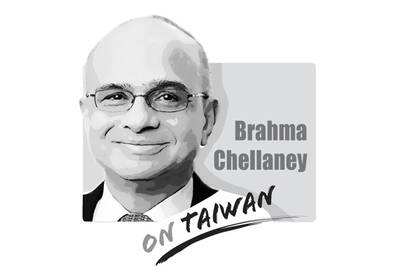US President Donald Trump’s administration is considering rescinding the previous administration’s restrictions on artificial intelligence (AI) chip exports, which were set to take effect on Thursday.
The White House said that sorting countries into three tiers subject to specific AI-related trade regulations is too complex and unenforceable, international media reported. The Trump administration is working toward new regulations to keep advanced AI technology out of the hands of foreign adversaries.
While the exact timetable for the new rules is unknown, the latest development boosted US technology stocks last week, as investors welcomed the US government’s recognition that reasonable regulations are needed to sustain growth and innovation in the tech sector. The move is also likely to have implications for Taiwan’s semiconductor and electronics industries.
Another issue worthy of close attention is the US government’s decision on whether to impose steep tariffs on imported semiconductors, following the closure on Wednesday last week of the comment window for Section 232 of the US Trade Expansion Act investigation into semiconductor imports.
The Trump administration might announce semiconductor tariffs soon based on the results of the probe, with some suggesting Washington could impose tariffs of between 25 percent and 100 percent on chip imports.
Although US Customs and Border Protection on April 11 included products such as smartphones, PCs, servers, chipmaking equipment and other consumer electronics on a list that would be exempted from the US’ latest round of tariffs, such products would likely be included in the potential semiconductor tariffs, international media reported, citing Trump officials.
In other words, when the US government announces its new semiconductor trade ruling, it might also clarify whether such tech products would retain their exemption status or be reclassified under a different tariff category.
As Trump’s trade policies unfold, the US government’s talks with major trading partners continue to weigh on market sentiment. Taiwan has made progress in trade negotiations with the US, but at the same time, the New Taiwan dollar has continued to fluctuate against the US dollar.
Although the government has strongly denied that the NT dollar’s exchange rates were part of trade negotiations, worries over tariffs and the local currency’s rapid appreciation have dominated headlines across multiple news outlets over the past week.
The push to finalize Trump’s tax reform package and his goal of reducing the US’ trade deficit is beginning to take shape, with the White House rushing to reach trade deals with multiple countries. This would likely spur market speculation over rising exchange rates in counterpart economies — and inevitably the strengthening of the NT dollar.
However, none has been appreciating as much as the NT dollar, which has exhibited more volatility than ever before, putting greater pressure on export-oriented businesses from electronics to semiconductors and traditional industries.
It remains unclear whether the Trump administration’s trade deals could lead to a meaningful reduction in tariffs, but one thing that is certain is that the US president’s aggressive tariff moves have rattled investors’ confidence in the US dollar and cast uncertainty over the appeal of US assets.
Against this backdrop, Taiwanese investors and exporters should think seriously about hedging, if not reducing, their exposure to US dollar-denominated assets, as well as exploring portfolio diversification. At the same time, the government, confronted with mounting challenges, from trade negotiations with the US to the restructuring of the international economic landscape, should formulate an effective, credible response strategy to restore public trust.

China badly misread Japan. It sought to intimidate Tokyo into silence on Taiwan. Instead, it has achieved the opposite by hardening Japanese resolve. By trying to bludgeon a major power like Japan into accepting its “red lines” — above all on Taiwan — China laid bare the raw coercive logic of compellence now driving its foreign policy toward Asian states. From the Taiwan Strait and the East and South China Seas to the Himalayan frontier, Beijing has increasingly relied on economic warfare, diplomatic intimidation and military pressure to bend neighbors to its will. Confident in its growing power, China appeared to believe
Taiwan-India relations appear to have been put on the back burner this year, including on Taiwan’s side. Geopolitical pressures have compelled both countries to recalibrate their priorities, even as their core security challenges remain unchanged. However, what is striking is the visible decline in the attention India once received from Taiwan. The absence of the annual Diwali celebrations for the Indian community and the lack of a commemoration marking the 30-year anniversary of the representative offices, the India Taipei Association and the Taipei Economic and Cultural Center, speak volumes and raise serious questions about whether Taiwan still has a coherent India
Recent media reports have again warned that traditional Chinese medicine pharmacies are disappearing and might vanish altogether within the next 15 years. Yet viewed through the broader lens of social and economic change, the rise and fall — or transformation — of industries is rarely the result of a single factor, nor is it inherently negative. Taiwan itself offers a clear parallel. Once renowned globally for manufacturing, it is now best known for its high-tech industries. Along the way, some businesses successfully transformed, while others disappeared. These shifts, painful as they might be for those directly affected, have not necessarily harmed society
Legislators of the opposition parties, consisting of the Chinese Nationalist Party (KMT) and the Taiwan People’s Party (TPP), on Friday moved to initiate impeachment proceedings against President William Lai (賴清德). They accused Lai of undermining the nation’s constitutional order and democracy. For anyone who has been paying attention to the actions of the KMT and the TPP in the legislature since they gained a combined majority in February last year, pushing through constitutionally dubious legislation, defunding the Control Yuan and ensuring that the Constitutional Court is unable to operate properly, such an accusation borders the absurd. That they are basing this